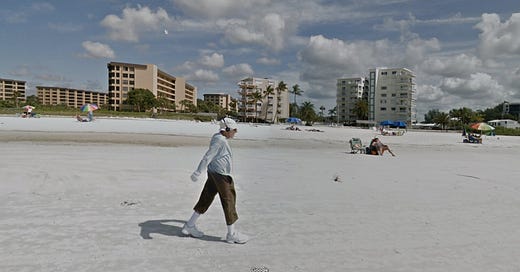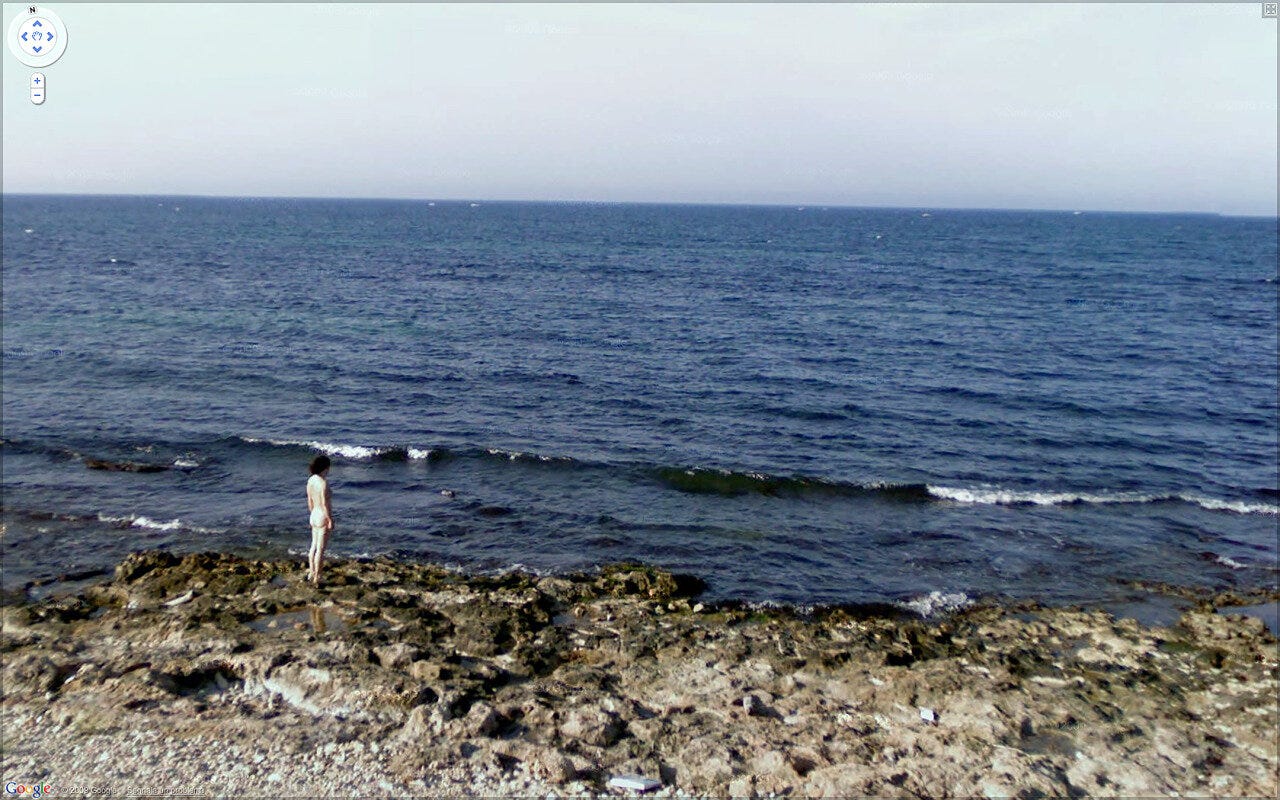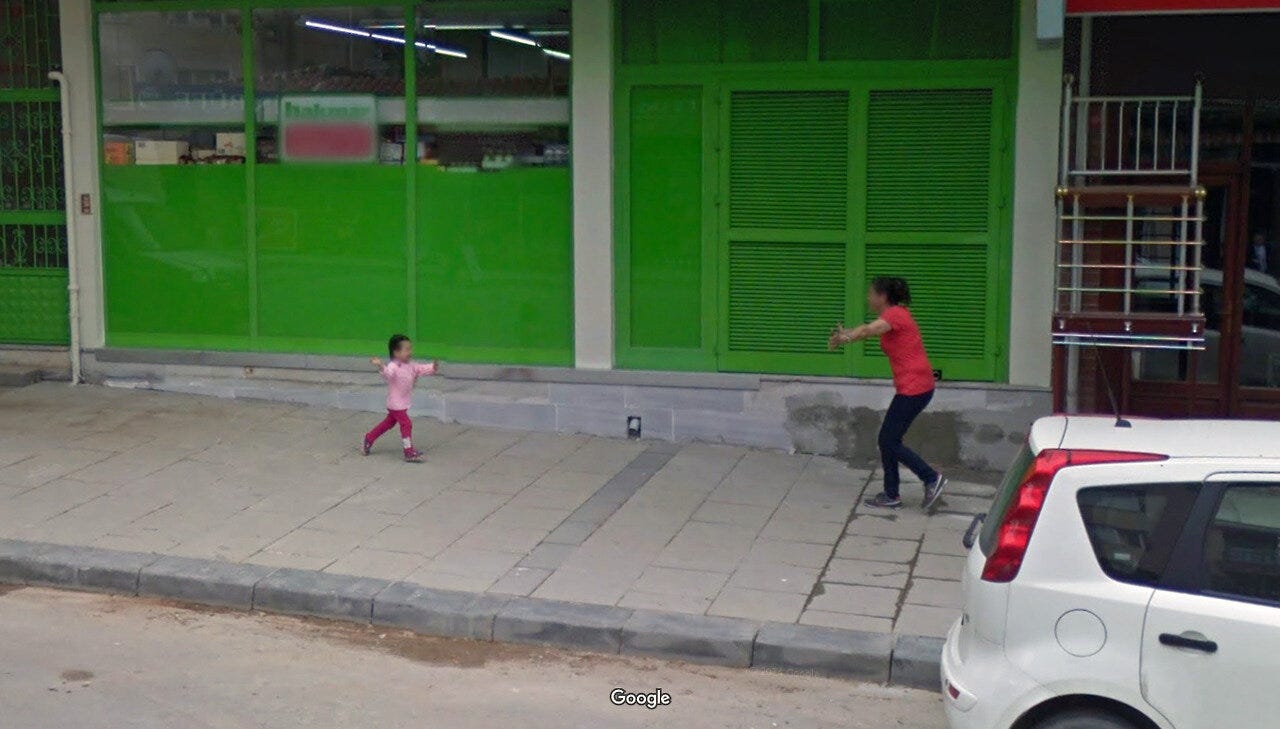[from the archives] extremely online
from May 2021. on online worlds, identities, practices, and their blurring. feat. Patricia Lockwood, Jia Tolentino, Jane Kenyon and others.
The artwork in this issue is curated by Jon Rafman, whose ongoing (since 2008) project Nine Eyes is a visual repository of Google Street View images. It’s a haunting, hilarious, humanizing and dehumanizing look at a digital archive both erasing and made up of human (+ nonhuman) relations. Rafman’s curations raise questions about consent, anonymity, and authorship in the Age of the Internet.
hello friend,
“If, when you’re lying down at night, a bubble seems to open, just off to the side of your left temple, where the discourse continues even as you sleep, then you’re extremely online. And, if, in the mornings, you feel a physical lurch toward your phone to pick up the conversation again and continue yourself in it, then you’re probably extremely online…”
I recognize myself more than I’d like to admit in this interview with Patricia Lockwood on “being extremely online.” How do these words land with you?
Granted, most of us have lived this past pandemic year+ in “extremely online” (or at least more online) ways. In fact, being “extremely online” in this time has been a survival tool, a coping tactic, a way to keep others, and ourselves, alive without also losing our minds. A space to outsource internal chaos, or to internalize the rumblings of a mad world. What even counts as extreme, when the needle has moved? As we endure one of the more extreme collective experiences of our era?
And what do we do with all our (overwhelmingly online) pandemic coping tactics?
Sometimes, it hits: a fleeting awareness of how instinctive, routine, inevitable this “being online” has become. As Jia Tolentino writes in Trick Mirror: “Now I’m thirty, and most of my life is inextricable from the internet, and its mazes of incessant forced connection—this feverish, electric, unlivable hell.” How did I get here?
And what even is this line, which we are presumably either on or off?
I’ve recently (read: always) questioned my relationship with the Internet, social media, and “being online,” but in a semi-ambivalent way. It’s a shadow I’d rather not venture into. I’ve always admired the people who can freely waltz from “IRL” to Online, take long swaths of time away from their screens, and not mindlessly lose themselves in doomscrolling. Or, like my one of my mentors, abscond the whole thing altogether, carrying a Nokia brick which solely makes calls and refusing to have their picture appear online; extremely and decidedly offline.
Yes, I’ve tried the “tech Shabbat” s (T and I started a Friday night/Saturday morning phone-free ritual and it is quite nice). I’ve read the Digital Minimalism s and the How To Do Nothing s; seen and been disgusted by The Social Dilemma s; installed the ScreenTime tracker s and Freedom app s. I understand, intellectually, that the capitalist attention economy is exploiting our “freely offered” “content.” But all the questions and ambivalence are still there, waiting for me, when I return to the screen. Being an anthropologist of technology both does and doesn’t help.
For me, this presumed “line” is not a line I’m either on or off; it is more like a black hole I am either in or out (of). Sometimes, when I fall in, I can disappear.
Like most things I ignore long enough, it shows up in my body. An allergic reaction, a side-effect of senses subdued by the hyper-visualisation of being online. Now I feel it: floating head, ears filled with water, blurriness. Exhausted, overwhelmed, a draught of any original thought or idea. An embodied aversion; resistance.
On my running list of topics to write you, each month “the Internet” hangs out in second-place, with “Burnout” a close third (they are, of course, neighbors). It feels a bit trite to write about being online now, when the phrase “Zoom fatigue” is itself becoming tired. We are well-versed in critiques from long before the pandemic: that (most) everything on social media is a curated highlight real (yes, even displays of vulnerability can still be performances); that censorship and surveillance are built-in to invisible/nefarious algorithms; that these glass-metal-microchip blocks (/extensions of ourselves?) are pocket-sized slot machines profiting off addiction.
And yet. I can’t write about the Internet without acknowledging all its connecting facilities & gifts. Living across the world from many loved ones, I’m indebted to the way the Internet flattens geographic distance, particularly during the pandemic. It has catalyzed my own creativity via this newsletter and Within: creations that have brought me closer to humans in meaningful ways, and to which I remain deeply committed. AND, yes, I did in fact meet the love of my life online, which is bar none the best thing the Internet has done (or ever will do) for me.
The Internet is, and always has been, the epitome of a BOTH/AND situation (see vol. 01 issue 11 in the archives), a beautiful paradox. What it does unto us and what we do unto it are interrelated. I am not here to moralize Internet use or suggest that there is any particular way to be online. All of this is intensely personal and ever-shifting. As May is Mental Health Month (tbh every month is, when you live with a sparkly and overactive/anxious mind, hi!), I just want to normalize feeling unsure about, and possibly even troubled by, your relationship with being online. And normalize being gentle with yourself as you might try, as I am, to (re)define it.
Vol. 02, Issue 05 of T H E | L I M I N A L meditates on the liminality of online worlds, identities, and practices. We have a beautiful PORTRAITS conversation with Broadway dancer and recent Duke MFA grad Courtney Liu about embodiment, flow, and dance, returning to the body amidst hyper-visualization, on &/off -line.
There is no map drawn; we are the first generation of humans traversing this digital subjectivity. Hell, the World Wide Web is 32 years old, Instagram is 9, and TikTok has not even blown out 5 candles, just for a little perspective.
To echo the one thing the Internet always reminds us: you’re not alone.
xx, A
Google Street View screenshot curated by Jon Rafman.
VOICE
A reminder of the delicacy, fragility, and utter gift of analog dailiness. Written by Jane Kenyon, published posthumously in 1995.
I got out of bed
on two strong legs.
It might have been
otherwise. I ate
cereal, sweet
milk, ripe, flawless
peach. It might
have been otherwise.
I took the dog uphill
to the birch wood.
All morning I did
the work I love.
At noon I lay down
with my mate. It might
have been otherwise.
We ate dinner together
at a table with silver
candlesticks. It might
have been otherwise.
I slept in a bed
in a room with paintings
on the walls, and
planned another day
just like this day.
But one day, I know,
it will be otherwise.
Google Street View screenshot curated by Jon Rafman.
MUSINGS OF THE MOMENT
extremely online and incredibly close
Lately I’ve been thinking a lot about what coming of age with the Internet does to a) our brains, b) our bodies and sense of space, and c) writing.
I’m also getting curious about how being online is the #1 way I avoid rest and how my creative energy is both stoked and completely extinguished by social media.
Here are, in no particular order, a few pieces I’ve been in conversation with, interspersed with questions of my own:
In her 2014 essay “A Memoir is Not a Status Update,” Dani Shapiro contemplates how her writing would be different had she come of age as a writer “during those years of living out loud.” She quotes Adrienne Rich: “It is always what is under pressure in us, especially under pressure of concealment—that explodes in poetry.” What happens to our art when our finger is always on the release valve and we’re never quite concealed?
What is the relationship between creativity and consumption? How does my energy shift when I consume before I create? create before I consume?
Inspired by this conversation with Marlee Grace: What is the relationship between performance and practice in online life, and how can the ways I show up online align more with practice (imperfect, messy, growing) than performance (showcasing, buttoned up, perfectionism)?
Why does the fact that this phone needs to exist make me feel squirmy and wonder if we’re all living in a dystopian universe?
What does it feel like in my body when I pick up my phone and open Instagram?
What need am I trying to meet? What feeling am I trying to avoid?
How do I best protect and honor my energy, on and off this line?
WRITING PROMPT
The next time you find yourself picking up your phone or going online, take a moment to pause and check in. If you can, grab pen and paper and write from the following…
What need am I trying to fill, in this moment?
Where in my body am I feeling a sensation? What does it feel like? Can I write from this space, this voice, this feeling?
Google Street View screenshot curated by Jon Rafman.
PORTRAITS
PORTRAITS returns this month with an inspiring conversation with Courtney Liu, Broadway dancer and ballet teacher.
Courtney and I met at Duke (T’ 13) as undergraduates, where she also recently completed her MFA in Dance as part of the program’s inaugural cohort. After watching Courtney’s riveting MFA choreography and her compelling thesis presentation about the intersection of flow states, body image, and dance pedagogy, I reached out to learn more about her exciting work and art (which includes #garageballet — read on to find out what this means).
Join us below for a conversation about embodiment, body image, falling in love with one’s body, and adapting ballet teaching and dancing online during the pandemic.
Courtney Liu :: Flow, Body Image, & Dance
“When was the last time you felt wholly alive in your body? When every fiber of your thinking, moving, breathing being was engaged in an activity?” Courtney Liu, a Broadway ballet dancer and dance
EXCERPTS:
“It is paramount to me that the student does not feel like they are trying to squeeze themselves into a ballet box that is historically thin, white, heterosexual, and able-bodied. Rather, I encourage students to work from an inside-out, somatic perspective in my class – to find the way the lines of ballet feel in their own bodies.”
“There is a good amount of clinical research on how to treat eating disorders once they develop, but not a lot of information on how dance teachers can prevent the kinds of thinking and the negative body image that can lead to disordered eating and eating disorders.”
“When I think of “liminal” moments I think of the times in my life when I recommitted myself to dance.”
OFFERINGS
WITHIN
WITHIN, my series on embodied writing, returns for SEASON 3 in FALL 2021! Embodiment practices to reclaim your creative voice, via yoga, meditation, breath, and writing, all in a supportive and inspiring global community.
Over the course of 12 weeks (September - November) we’ll gather for 6 live practices. The in-between spaces are filled with personal practices, rituals, partnerships, readings and writing inspiration to support your journey within. There is an on-demand (non-live) option too for those with unpredictable schedules or incompatible time zones.
The most beautiful thing about WITHIN, bar none, is its humans, who have gathered together from 10+ countries, time zones spanning LA to Australia, to practice and inquire within. I know many of us are eager to return to IRL gatherings, but also maybe trepidatious. I can assure you this practice and community is extremely human, and most of the time is spent in your body/on your mat or staring into the empathic, supportive faces of your community. Join us in inquiry, movement, and creative expression!
Registration opens in July — sign up for the waitlist to enter your time preferences and to be the first to know when registration opens!
RESOURCES
READING:
I’ve been swimming in memoirs as of late: Blow Your House Down by Gina Frangello and Girlhood by Melissa Febos are up next.
LISTENING:
Recently stumbled upon Avni Trivedi’s Speak from the Body podcast and am loving it.
DOING:
#1000wordsofsummer ! Hooray for the generative power of a global online (yes online!) community of writers doing the damn thing. Join me from May 31 to June 13th, 1000 words a day.
To join, subscribe to Jami Attenburg’s substack linked above, where you’ll get daily inspiration/encouragement along with access to a Slack group of 13,000+ other writers.
GIVING:
Donate to the George Floyd Foundation in honor of George Floyd’s legacy and to help end the systemic violence that is killing Black Americans.
Google Street View screenshot curated by Jon Rafman.
PLAYLIST OF THE MONTH










